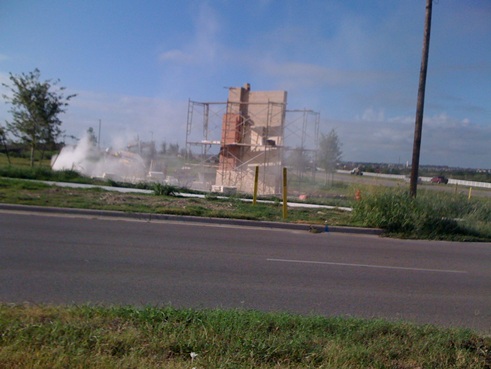Occupational health hazards are often hidden, and may not even be appropriately disclosed to workers who are exposed. They are usually shielded from public view, meaning they don't get the attention needed to ensure protections are put in place to address them. But every once in a while, hazards to workers' health are right in front of you.
Yesterday morning, I was driving on FM 1626 in Kyle, TX and passed this scene: Two construction workers standing in a nasty cloud of dust. The men were working at the new campus of Austin Community College in Hays County, TX and were cutting stone using a masonry saw.
The saw was obviously not equipped with a mini water pump to damp down the dust. If the stone they were cutting through contains crystalline silica and this kind of dusty task is a routine part of their job, the workers are at risk of developing silicosis, or another silica-related disease. It’s the occupational health hazard addressed in a regulation proposed last month by the Occupational Safety and Health Administration (OSHA).
In order to protect workers from the adverse health effects of exposure to respirable silica dust---and to make it easy for employers to comply with the rule---OSHA is proposing that employers use practical and inexpensive ways to control dust. For the tool that these men were using, it should be equipped with an integrated water delivery system. If an employer follows that simple practice, OSHA will assume the task is in-compliance with their regulation.
Predictably, several trade associations have already expressed opposition to OSHA’s silica proposal. They list a slew of reasons why this worker safety regulation is not necessary. One argument is that workers would be adequately protected if the agency simply enforced the silica rule that is already on the books. Just a moment’s thought about that idea and one sees how ludicrous it is.
What I witnessed yesterday---workers in a cloud of dust---takes place thousands of times every day in the U.S. Opponents of the proposal must think we are dopes to believe the suggestion that OSHA inspectors could be at every construction site to make sure the contractors are following the law. These opponents know full well that nationwide there are less than 900 federal OSHA inspectors. In the big State of Texas, it would take OSHA 126 years to inspect each workplace just once. Who are they trying to fool with their lame argument? But, we can rest assured they’ll have plenty more of the same.
As for the workers I saw yesterday in that white cloud of dust, the construction contractor for building project is Flintco. Their headquarters is located in Tulsa, OK, and their motto is “Safety-first, Quality first, Client driven.”
The orange vests the workers were wearing may symbolize “safety-first,” but Flintco seems to have a major gap in addressing occupational health hazards, such as dust exposure. I’m not sure they really have safety hazards covered that well either. The scaffold looks unstable and dangerous to me.

